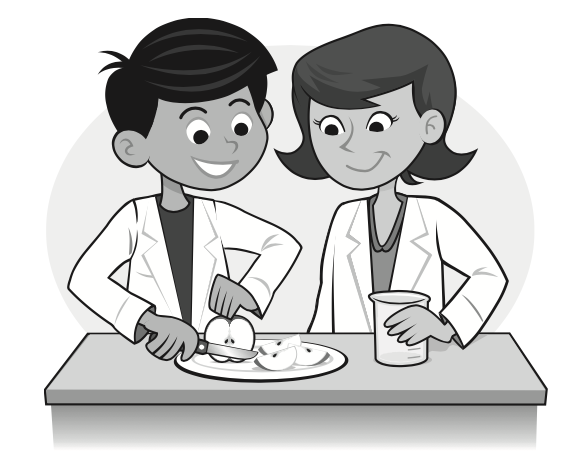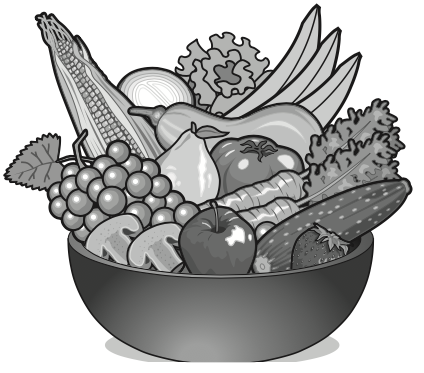Lesson Plan
The Chemistry of Fruits and Vegetables
Grade Level
Purpose
Students examine fruit and vegetable preparation and storage. Grades 3-5
Estimated Time
Materials Needed
Engage:
- 2 bowls of cut produce (such as fruit salad), one treated with lemon juice
Activity:
- The Chemistry of Fruits and Vegetables activity sheet
- 2 different fruits (apple, avocado, peach, plum, or pear)
- 2 different vegetables (potato, eggplant, zucchini, sweet potato, or carrot)
- 12 paper or plastic plates
- Knife
- Plastic wrap
- Treatment chemicals: lemon juice, pineapple juice, ascorbic acid solution, sodium bicarbonate solution, citric acid solution
Vocabulary
ascorbic acid: another name for vitamin C; necessary in the body for healthy cells
chemical reaction: when two materials mix and react to make something new (sometimes good, sometimes bad)
enzyme: protein catalyst, which speeds up a specific chemical reaction
fruit: the part of a plant that develops from the flower and contains the seeds of the plant
oxidation: a chemical reaction between oxygen and other compounds
produce: fresh fruits and vegetables
vegetable: any edible part of a plant that does not contain seeds
Background Agricultural Connections
This lesson is part of a series called Fruits and Vegetables for Health, which introduces students to the production, distribution, and nutritional value of fresh produce. Students will gain knowledge in geography, language arts, science, and math as they learn about the process through which fruits and vegetables are transported from farms to kitchen tables. Other related lessons in this series include:
- Making Half MyPlate Fruits and Vegetables
- California Crops: From the Farm to the Table
- Nutritional Value of Fresh Produce
- The Chemistry of Fruits and Vegetables
- My Life as a Fruit or Vegetable
All plants are made up of living cells that are held together by cell walls. When some fruits and vegetables are cut, the cell walls are broken and a chemical reaction occurs which causes the cut surfaces to darken. The chemical reaction is caused by exposure of the fruit or vegetable to oxygen in the air. This chemical reaction is called oxidation and is promoted by enzymes that are released when the cells are cut open. Fruits and vegetables that have been discolored from oxidation are still edible, despite the change in appearance. The chemical reaction that causes darkening will not occur when:
- Ascorbic acid is present naturally in the fresh produce, or added immediately after cutting.
- The produce is heated to destroy the enzymes that cause discoloration due to oxidation.
- The food is covered to prevent oxygen from entering the cut cells.
Bruised and blemished produce is also edible if the imperfections are removed with a knife. However, moldy fruit and vegetables should be discarded because some molds produce toxins that are potentially harmful.
In this lesson, students wil experiment with fruits and vegetables to determine the best method to prevent discoloration.
It is important to discuss with students that the agricultural industry establishes guidelines about how fresh produce should be shipped and stored so that quality produce gets to the consumer. It is equally important to discuss with students the appropriate produce storage and handling techniques they should use at home.
Engage
- At least five hours prior to class,
 prepare two bowls of fresh fruit salad. Liberally apply lemon juice to one of the bowls.
prepare two bowls of fresh fruit salad. Liberally apply lemon juice to one of the bowls. - Show the class the two bowls of fruit salad. Ask the students to choose which of the fruit servings they would prefer to eat. Have the students share why they prefer one bowl over the other.
- Ask the students why they think the salads look different. Collect responses from the students and write them on the board. If they suggest that one is older than the other, explain that they were prepared at the same time. Building upon the students' ideas, reveal that the more appealing fruit was treated with a natural chemical found in lemons called ascorbic acid.
- Explain to the students that in this lesson they will be challenged to find a way to prevent a variety of fruits and vegetables from turning brown.
Explore and Explain
Activity:
- Divide the class into cooperative groups of 3-4 students. Explain to the students that their challenge is to find a way to prevent a variety of fruits and vegetables from turning brown.
- Outline the safety requirements students should follow when using a knife.
- Introduce the potential treatment options for the fruits and vegetables:
- Lemon juice
- Pineapple juice
- Sodium bicarbonate solution (1 teaspoon of baking soda dissolved per 100 mL of water)
- Ascorbic acid solution (1 crushed vitamin C pill dissolved per cup of water)
- Citric acid solution (1 gram of citric acid dissolved per 1000 mL of water)
- Plastic wrap
- Have the students record their hypotheses on The Chemistry of Fruits and Vegetables activity sheet.
- Instruct groups to select two types of vegetables and two types of fruit for their experiment. Students will need to slice three equal portions (one control and two different treatments) of each fruit and vegetable.
- Without delay, treat the three slices of each type of fresh produce as follows:
- First slice: leave exposed to the air (the control)
- Second slice: apply treatment of choice to all exposed surfaces
- Third slice: apply different treatment of choice to all exposed surfaces
- Have the students record their observations on The Chemistry of Fruits and Vegetables activity sheet. Observations should be made and recorded immediately after cutting and at regular 10-minute intervals for 30 minutes.
- After the students make their final observations, hold a class discussion about produce discoloration and the effect different treatments have on fresh produce. Take time to discuss the real-life application of their experiment, as well as the types of discoloration that affect the healthfulness of food, such as mold and bruising.
- Have the student groups discuss the results as well as draw and write conclusions. Students should be able to make conclusions about the following and then complete their activity sheets:
- How does the naturally occuring ascorbic acid content of different types of produce affect the rate in which they brown?
- What treatment is most effective in preventing discoloration?
- As consumers, how will the results of this experiment affect how they store food?
- As scientists, what additional information would they want to know before marketing their solution to consumers?
Variations
- Have the students write a formal lab report, which includes a purpose, hypothesis, materials list, procedure, results, and conclusion.
- Before the activity, have the students predict what the results of the experiment will be (hypothesis). After the experiment, have the students compare their data with their predictions.
Elaborate
-
Conduct a blind taste test. Divide the students into groups. Have each group select a student to be a taster and blindfold him or her. Give this student a freshly cut piece of fruit, then give him or her a piece of the same kind of fruit that has oxidized (turned slightly brown). Have the taster comment on the differences in taste and texture.
-
Bring in ready-cut produce from the grocery store, such as broccoli florets, apple slices, pineapple, sweet potato sticks, cauliflower florets, or baby carrots. Examine why consumers purchase products pre-cut, and research how packaging is designed to extend the shelf life.
Evaluate
After conducting these activities, review and summarize the following key concepts:
- When some fruits and vegetables are cut, the cell walls are broken and a chemical reaction occurs which causes the cut surfaces to darken due to exposure to oxygen in the air. This chemical reaction is called oxidation.
- Fruits and vegetables that have been discolored from oxidation are still edible, despite the change in appearance.
- The chemical reaction that causes darkening will not occur when ascorbic acid is naturally present or added, the produce is heated, or the food is covered.
Acknowledgements
This lesson was originally developed in 1996 through a partnership between the Fresh Produce and Floral Council, the California Farm Bureau Federation, and the California Foundation for Agriculture in the Classroom. Fruits and Vegetables for Health was updated in 2012 in partnership with the California Department of Public Health's Network for a Healthy California with funding from USDA SNAP, known in California as CalFresh (formerly Food Stamps). Funding for 2017 updates were provided through a California Agriculture Special Interest License Plate grant (CalAgPlate) that supports agricultural education, agricultural career training, and agricultural leadership development.
Orignal Authors: Brenda Byers and Priscilla Naworski
Executive Director: Judy Culbertson
Illustrator: Erik Davison
Layout and Design: Nina Danner
Special thanks to Harvest of the Month
Recommended Companion Resources
Author
Organization
| We welcome your feedback! If you have a question about this lesson or would like to report a broken link, please send us an email. If you have used this lesson and are willing to share your experience, we will provide you with a coupon code for 10% off your next purchase at AgClassroomStore. |